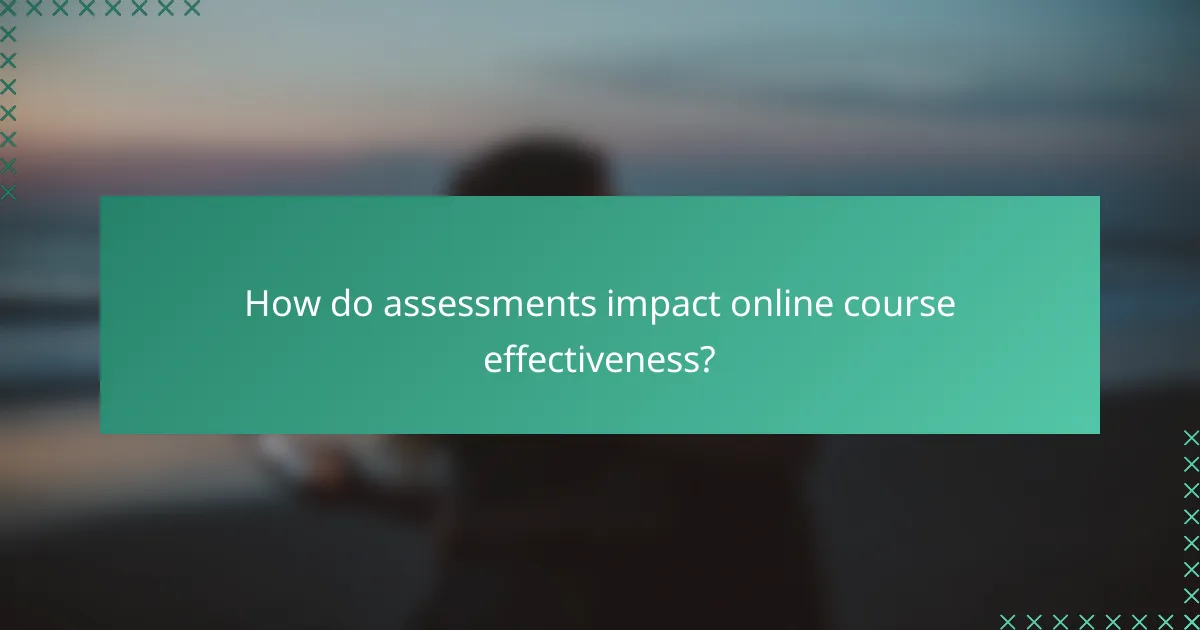Online courses have the potential to significantly improve content quality and learner engagement by employing structured instructional design and multimedia elements. By fostering interaction through gamification and community building, these courses can enhance the learning experience. Additionally, understanding the factors that influence completion rates, such as course structure and instructor support, is crucial for creating effective educational programs that motivate students to succeed.

How can online courses improve content quality?
Online courses can enhance content quality by implementing structured approaches that focus on effective learning outcomes. By utilizing instructional design principles, incorporating multimedia, and ensuring regular updates, courses can maintain relevance and engagement.
Utilizing instructional design principles
Instructional design principles guide the creation of effective learning experiences. These principles include defining clear learning objectives, organizing content logically, and assessing learner progress through formative evaluations. For instance, using the ADDIE model (Analysis, Design, Development, Implementation, Evaluation) can help course creators systematically improve course structure.
When applying these principles, consider the target audience’s needs and learning styles. Tailoring content to different preferences can significantly enhance comprehension and retention, leading to better overall course quality.
Incorporating multimedia elements
Multimedia elements, such as videos, infographics, and interactive quizzes, can significantly enrich online courses. These components cater to various learning styles, making the material more engaging and easier to understand. For example, a short video can explain complex concepts more effectively than text alone.
However, it’s essential to balance multimedia use. Overloading a course with too many elements can distract learners rather than aid their understanding. Aim for a mix that complements the content without overwhelming the learner.
Regular content updates
Keeping course content up-to-date is crucial for maintaining quality and relevance. Regular updates ensure that learners receive the latest information and best practices in their field. This is particularly important in fast-evolving industries like technology and healthcare.
Establish a schedule for reviewing and revising course materials, ideally every few months. Encourage feedback from learners to identify areas needing updates, which can help keep the content fresh and engaging.
Expert contributions
Incorporating insights from industry experts can greatly enhance the quality of online courses. Experts can provide real-world examples, case studies, and current trends that enrich the learning experience. Collaborating with professionals ensures that the content is accurate and reflects the latest developments in the field.
Consider inviting guest speakers for webinars or including interviews in course materials. This approach not only boosts credibility but also adds a dynamic element to the learning process.
Peer-reviewed materials
Using peer-reviewed materials in online courses ensures that the content is credible and scientifically sound. These resources have undergone rigorous evaluation by experts, which adds an extra layer of trustworthiness. Incorporating such materials can enhance the academic integrity of the course.
When selecting peer-reviewed resources, ensure they are relevant and up-to-date. Providing learners with access to these materials can also encourage critical thinking and deeper engagement with the subject matter.

What strategies enhance engagement in online courses?
Enhancing engagement in online courses involves implementing strategies that actively involve learners and foster interaction. Key approaches include incorporating interactive learning activities, gamification techniques, real-time feedback mechanisms, and community building through forums.
Interactive learning activities
Interactive learning activities, such as quizzes, simulations, and hands-on projects, significantly boost student engagement. These activities encourage learners to apply concepts in practical scenarios, making the material more relatable and memorable.
To maximize effectiveness, design activities that require critical thinking and collaboration. For instance, group projects can enhance peer interaction and deepen understanding of the subject matter.
Gamification techniques
Gamification techniques, such as points, badges, and leaderboards, can motivate learners by adding an element of competition and achievement. This approach taps into intrinsic motivation, encouraging students to complete tasks and engage more deeply with the content.
When implementing gamification, ensure that the rewards align with learning objectives. For example, offering badges for completing modules can incentivize progress while reinforcing key concepts.
Real-time feedback mechanisms
Real-time feedback mechanisms, such as instant quizzes and interactive polls, allow learners to receive immediate responses to their performance. This timely information helps students identify areas for improvement and reinforces their understanding of the material.
Incorporate tools that provide analytics on student performance, enabling instructors to tailor their support and address common misconceptions promptly. Regular feedback loops can significantly enhance the learning experience.
Community building through forums
Building a community through forums fosters a sense of belonging and encourages collaboration among learners. Online discussion boards allow students to share insights, ask questions, and support each other, enhancing overall engagement.
To create an effective forum, set clear guidelines for participation and encourage regular interaction. Consider assigning discussion topics or prompts to stimulate conversation and keep the community active.

What factors influence completion rates in online courses?
Completion rates in online courses are influenced by several key factors, including course structure, instructor support, motivational incentives, and clear learning objectives. Understanding these elements can help educators design more effective courses that encourage students to finish.
Course structure and pacing
The way a course is structured and paced significantly affects student engagement and completion. Courses that are well-organized, with a logical flow and manageable workload, tend to keep learners motivated. For instance, breaking content into smaller, digestible modules can help students progress without feeling overwhelmed.
Additionally, offering flexible pacing options allows students to learn at their own speed, accommodating different schedules and learning styles. This flexibility can lead to higher completion rates, as learners can balance their studies with other commitments.
Instructor support and availability
Instructor support plays a crucial role in student retention and course completion. When instructors are readily available to answer questions and provide feedback, students feel more connected and supported in their learning journey. Regular interaction through live Q&A sessions or discussion forums can enhance this support.
Moreover, timely feedback on assignments can motivate students to stay engaged and improve their performance. Instructors should aim to create a welcoming environment where students feel comfortable seeking help and sharing their challenges.
Motivational incentives
Incentives can significantly boost student motivation and completion rates in online courses. Offering certificates, badges, or other forms of recognition can encourage learners to finish the course. These incentives provide tangible rewards for effort and achievement, making the learning experience more rewarding.
Additionally, incorporating gamification elements, such as leaderboards or progress tracking, can create a sense of competition and accomplishment. These strategies can help maintain student interest and commitment throughout the course.
Clear learning objectives
Establishing clear learning objectives is essential for guiding students through an online course. When learners understand what they are expected to achieve, they are more likely to stay focused and motivated. Clear objectives help set expectations and provide a roadmap for success.
Instructors should communicate these objectives at the beginning of the course and revisit them throughout the learning process. This practice not only reinforces the goals but also helps students measure their progress and stay on track for completion.

What are the best platforms for online courses in the UK?
The best platforms for online courses in the UK include Udemy, Coursera, FutureLearn, and LinkedIn Learning. Each platform offers unique features, course types, and engagement strategies that cater to different learning needs and preferences.
Udemy for diverse topics
Udemy is known for its extensive library of courses covering a wide range of subjects, from programming to photography. With thousands of options, learners can find courses that fit their interests and skill levels.
When choosing a course on Udemy, consider the ratings and reviews from previous students to gauge content quality. Prices can vary significantly, often ranging from £10 to £200, so look for discounts and promotions to get the best deal.
Coursera for accredited courses
Coursera partners with universities and organizations to offer accredited courses, making it a great choice for those seeking formal recognition. Courses often include video lectures, quizzes, and peer-reviewed assignments.
Many courses are available for free, but obtaining a certificate typically requires a fee, which can range from £30 to £300. Check for financial aid options if cost is a concern.
FutureLearn for UK-based content
FutureLearn focuses on UK-based institutions, providing courses that often reflect local contexts and industries. This platform is ideal for learners interested in UK-specific topics or qualifications.
Courses are usually free to access for a limited time, with the option to purchase a certificate for completion. Expect to invest a few hours per week over several weeks to complete most courses.
LinkedIn Learning for professional development
LinkedIn Learning specializes in professional development, offering courses that enhance skills relevant to the job market. Topics range from software training to leadership development.
A subscription model allows unlimited access to courses for around £25 per month, making it a cost-effective option for continuous learning. Utilize the platform’s personalized recommendations to find courses that align with your career goals.

How do assessments impact online course effectiveness?
Assessments play a crucial role in determining the effectiveness of online courses by measuring learner understanding and engagement. They provide valuable feedback that can enhance the learning experience and improve completion rates.
Formative assessments for feedback
Formative assessments are tools used throughout a course to gauge student understanding and provide ongoing feedback. Unlike summative assessments, which evaluate learning at the end, formative assessments help instructors identify areas where students may struggle and adjust their teaching methods accordingly.
Examples of formative assessments include quizzes, polls, and peer reviews. These can be implemented frequently, allowing learners to receive immediate feedback and make necessary adjustments to their study habits. This approach can lead to higher engagement and better retention of course material.
To maximize the effectiveness of formative assessments, consider incorporating a variety of formats to cater to different learning styles. Avoid overloading students with too many assessments at once; instead, space them out to maintain engagement and reduce anxiety. Regularly review the feedback provided to ensure it is constructive and actionable.
